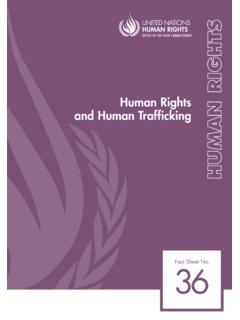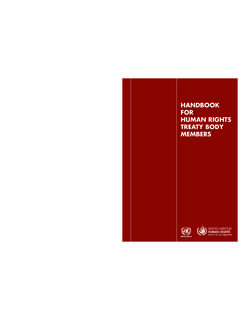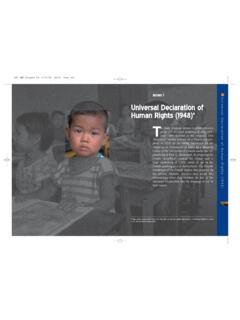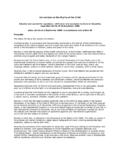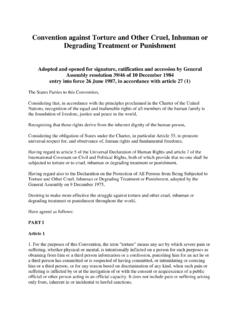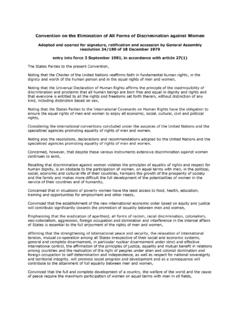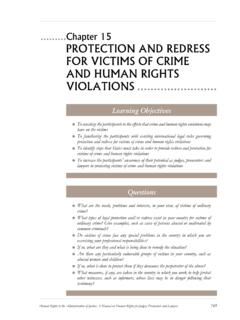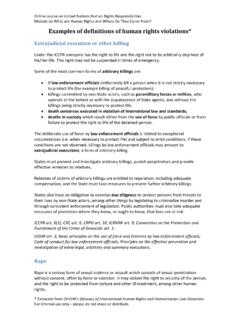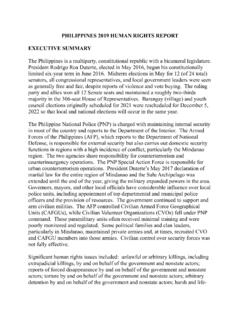Transcription of Report of the Ethiopian Human Rights Commission (EHRC ...
1 Report of the Ethiopian Human Rights Commission (EHRC)/Office of the United Nations High Commissioner for Human Rights (OHCHR) Joint Investigation into Alleged violations of International Human Rights , Humanitarian and Refugee Law Committed by all Parties to the Conflict in the Tigray Region of the Federal Democratic Republic of Ethiopia ii Table of Contents List of Acronyms/Glossary .. iv Executive Summary .. 1 I. Introduction .. 7 II. Methodology .. 8 III. Legal Framework .. 12 IV. Context .. 18 V. Issues and allegations arising under international humanitarian, Human Rights , and refugee law .. 22 A. Attacks on civilians and civilian objects, and other protected persons and objects22 B. Unlawful or extra-judicial killings and executions .. 29 C. Torture and other forms of ill-treatment.
2 32 D. Arbitrary detentions, abductions and enforced disappearances .. 36 E. Sexual and gender-based violence .. 40 F. Refugees .. 47 G. Forced displacement of the civilian 51 H. Internally Displaced Persons .. 55 I. Restrictions on freedom of movement .. 58 J. Freedom of expression and access to information .. 62 K. Pillage, looting and destruction of property .. 66 L. Denial of access to humanitarian relief .. 69 M. Economic, social and cultural Rights .. 73 N. Children .. 78 O. Older Persons and Persons with Disabilities .. 81 VI. Overall Findings .. 83 VII. Accountability .. 85 A. Introduction .. 85 B. Legal framework .. 85 C. National Mechanisms .. 87 D. International mechanisms .. 90 E. Conclusion .. 90 VIII. Recommendations .. 91 Annex I Map of Tigray Region .. 96 Annex II Actor Mapping.
3 97 iii iv List of Acronyms/Glossary African Charter African Charter on Human and Peoples Rights ACRWC African Charter on the Rights and Welfare of the Child ANDM Amhara National Democratic Movement ADP Amhara Democratic Party AP Additional Protocol ARDPF Amhara Region Disaster Prevention and Food Security Programme Coordination Office ARRA Agency for Refugee and Returnee Affairs ASF Amhara Special Forces CAT Convention against Torture CCI Council of Constitutional Inquiry CED International Convention for the Protection of All Persons from Enforced Disappearance CEDAW Convention on the Elimination of All Forms of Discrimination against Women CERD International Convention on the Elimination of All Forms of Racial Discrimination CIHL Customary International Humanitarian Law CMW International Convention on the Protection of the Rights of All Migrant Workers and Members of Their Families CPJ Committee to Protect Journalists CRC Convention on the Rights of the Child CRPD Convention on the Rights of Persons with Disabilities DRC Danish Refugee Council EDF Eritrean Defence Force EEU Ethiopia Electric Utility Company EHRC Ethiopian Human Rights Commission EMA Ethiopian Media Authority ENDF Ethiopian National Defence Force EPDM Ethiopian People s Democratic Movement EPRDF Ethiopian People s Revolutionary Democratic Front FAO Food and Agriculture Organization FDRE Federal Democratic Republic of Ethiopia GBV Gender-based Violence HIV Human Immunodeficiency Virus HoF House of Federation HoPR House of
4 Peoples Representative HRC Human Rights Committee ICC International Criminal Court ICCPR International Covenant on Civil and Political Rights ICESCR International Covenant on Economic Social and Cultural Rights ICJ International Court of Justice ICRC International Committee of the Red Cross ICTR International Criminal Tribunal for Rwanda v ICTY International Criminal Tribunal for the former Yugoslavia IDP Internally Displaced Person IHL International Humanitarian Law ILO International Labour Organization IMC International Medical Corps IOM International Organization for Migration IRC International Rescue Committee JIT Joint Investigation Team MoWCYA Ministry of Women, Children, and Youth Affairs MSF M decins Sans Fronti res NDRMC National Disaster and Risk Management Commission NEBE National Electoral Board of Ethiopia NISS National Intelligence and Security Service NGO Non-Governmental Organization OAG Office of the Federal Attorney General OAU Organization of African Unity OCHA United Nations Office for the Coordination of Humanitarian Affairs ODP Oromo Democratic Party OHCHR Office of the United Nations High Commissioner for Human Rights OLA Oromo Liberation Army OLF Oromo Liberation Front OP-CRC-AC Optional Protocol on the Involvement of Children in Armed Conflict OP-CRC-SC Optional Protocol on the Sale of Children.
5 Child Prostitution and Child Pornography OPDO Oromo Peoples Democratic Organisation OSC One-Stop-Centre PP Prosperity Party PPE Personal Protective Equipment PSNP Productive Safety-Net Programme PWD Persons with Disabilities SEPDM Southern Ethiopian Peoples Democratic Movement SGBV Sexual and Gender-Based Violence TIA Tigray Interim Administration TPLF Tigray People s Liberation Front TRJB Tigray Regional Justice Bureau TSF Tigray Special Forces UDHR Universal Declaration of Human Rights UN United Nations UNFPA United Nations Population Fund UNHCR UN Refugee Agency UNICEF United Nations Children's Fund UNSC United Nations Security Council WFP World Food Programme1 Executive Summary Introduction From 16 May to 30 August 2021, the Ethiopian Human Rights Commission (EHRC) and the Office of the United Nations High Commissioner for Human Rights (OHCHR) conducted a joint investigation into alleged Human Rights violations and abuses, and violations of international humanitarian law, and refugee law committed in the context of the conflict in Tigray, Federal Democratic Republic of Ethiopia.
6 The objectives of the joint investigation were to provide a faithful account of the Human Rights situation in Tigray including its gender dimension; further the accountability process and advocate for effective remedies; provide clear and actionable recommendations; and identify serious violations to ensure redress for victims and prevent recurrence. The investigation was carried out within the framework of relevant international legal norms, including international Human Rights law, humanitarian law, refugee law and criminal law, as well as Ethiopian domestic law. Prior to the commencement of the investigation, the Joint Investigation Team (JIT) agreed on its methods of work to guide the investigation and applied best practices regarding victim and witness protection, rules of procedure, international investigative standards, Report writing, and archiving.
7 Consistent with the practice of international fact-finding bodies, the JIT adopted a reasonable grounds to believe standard of proof for factual determinations on individual cases, incidents and patterns of violations . The JIT investigated alleged violations by all parties to the conflict from 3 November 2020 until the unilateral ceasefire declared by the federal government of Ethiopia on 28 June 2021. Field investigations were conducted from 16 May to 31 August 2021 in different locations in Tigray including Mekelle, Wukro, Samre and nearby areas, Alamata, Bora, Maichew, Dansha, Maikadra, and Humera. The JIT visited internally displaced persons (IDPs) camps in Mekelle, Gondar, Dabat, and Dansha, and, interviewed IDPs from various parts of Tigray, including Adi Aro, Adi Hageray, Adigrat, Adwa, Badme, Dengolat, Humera, Korem, Maikadra, Mekelle, Quiha, Shimelba, Shire, Sheraro, Tembien, and Zalambesa.
8 The JIT also conducted investigations in Addis Ababa and other affected locations such as Gondar and Bahir Dar. The JIT conducted 269 confidential interviews with victims and witnesses of alleged violations and abuses and held 64 meetings with federal and regional authorities, representatives of United Nations agencies and non-governmental organizations, community groups, medical personnel, and other sources. The Report does not purport to be an exhaustive record of all relevant incidents that occurred during this period, but it fairly illustrates the main types and overall patterns of violations and abuses over the period in question. Presentation in some of the thematic summaries follows a chronological pattern in terms of occurrences of incidents and does not imply a ranking of alleged perpetrators.
9 Findings On 3 November 2020, the Tigray Special Forces (TSF) and allied militia attacked the Northern Command of the Ethiopian National Defence Forces (ENDF) and took control of the bases and the weaponry. On 4 November 2020, the federal government announced a military operation against the Tigray People s Liberation Front (TPLF) and its forces. The ENDF, the Amhara Special Forces (ASF) and allied militia, and the Eritrean Defence Forces (EDF) accordingly started a military offensive against the TSF and allied militia in Tigray. The violent conflict resulted in serious violations of international Human Rights law, humanitarian, and refugee law. Based on the 2 information gathered and analysed by the JIT, there are reasonable grounds to believe that the following major violations and abuses occurred in the context of the conflict: Attack on civilians and civilian objects: The ENDF, EDF, and TSF, carried out attacks on civilians resulting in the deaths of and injuries to men, women, boys, and girls.
10 Civilian objects which enjoy special protection under international humanitarian law such as health facilities, schools, places of worship, and houses were indiscriminately attacked. Parties to the conflict failed to take sufficient precautions to protect civilians and civilian objects. ENDF and TSF occupied and used civilian infrastructure, such as schools and health facilities without appropriate justification for military usage. Twenty-nine civilians were killed in Mekelle due to shelling by the ENDF on 28 November 2020; 15 civilians were killed between 9 and 11 November 2020 in Humera due to artillery shells fired by the EDF and TSF; between 25 and 27 November 2020 an undisclosed number of civilians died in Wukro due to exchange of artillery fire between the ENDF and TSF, and several private and public property were damaged; a rocket fired by the TSF destroyed a farmer s home in the Amhara region 140 km from Gondar Airport causing injuries to a family of nine; shelling by ENDF in Amedwha, Waereb, and Dejen resulted in the death of two civilians and injuries to an unspecified number of people; 17 civilians were killed and 3 injured following ethnic-based attacks by TSF on two farms on the outskirts of Maikadra.
